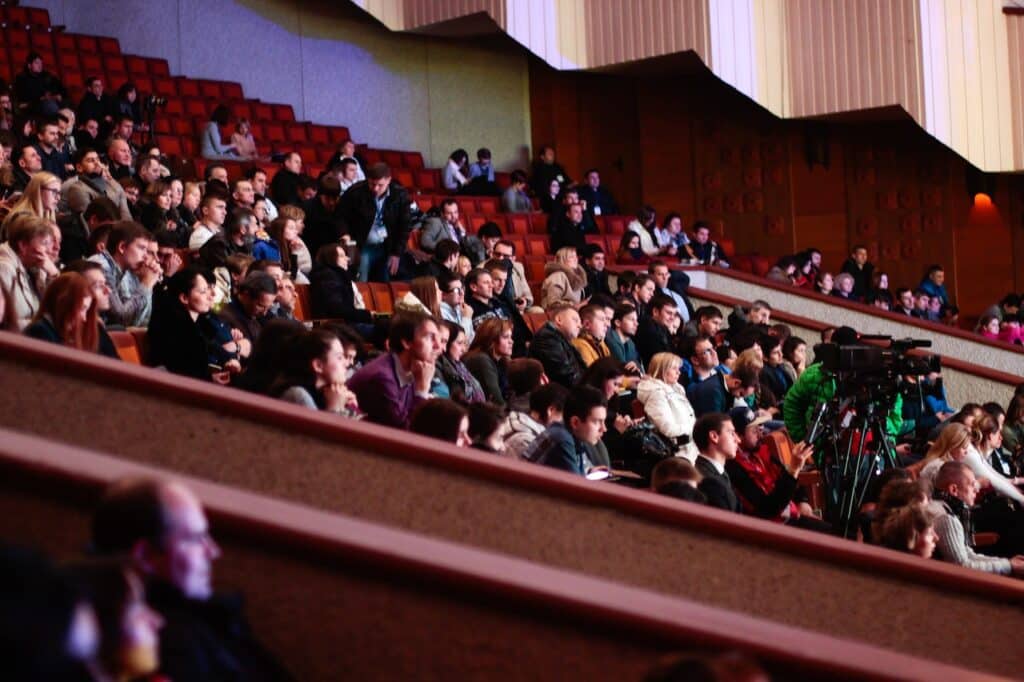Forget the stale cheese platters and mind-numbing PowerPoints; corporate events are stepping out of the shadows of banality. Think about it: you’ve got one shot to hit those branding moments, stir the networking pot, and achieve your milestone goals. And your corporate event planning efforts carry more weight than ever.
All eyes are on you, and the clock is ticking. It’s not just a gathering; it’s a pivot point for your business. Ready to see how the pros do it? We’re diving into the rarely-seen planning vault where all the event magic happens.
Part I: Pre-Event Groundwork
Setting the Stage: How to Define Your Corporate Event Planning Goals
Corporate event planning isn’t a casual affair you can slap together over the weekend. Nope, it’s more like laying the foundation for a skyscraper—every decision, big or small, plays into the structural integrity of the final product. Okay, let’s break it down.
Craft a Mission Statement for the Event
Before you send out invites or choose your hors d’oeuvres, you need a crystal-clear mission statement. This isn’t fluff; it’s your North Star. A well-crafted mission statement will steer you through the choices and challenges that await you. Do you want to empower your sales team, ignite brand evangelists among clients, or form a web of influential connections? Write it down and make it specific. A vague mission like “improving employee morale” won’t cut it.
Aim for specificity, such as “Boosting team cohesion by facilitating inter-departmental relationships.” There you go; now you have a compass that ensures you’re not just throwing money into the wind.
Prioritize Objectives: Networking, Branding, Product Launches
Your event is a ship, and you’re the captain. But even a ship can’t sail in three directions at once. So, what’s it going to be? Networking, branding, or maybe launching that revolutionary product you’ve been perfecting in the basement? Get your priorities straight because each goal requires different tactics, tools, and investments.
Let’s say networking is your top priority. You’ll want to create more open spaces in your venue for mingling and consider ice-breaker activities. If branding is the show’s star, every detail—from the welcome banner to the cocktail napkins—must scream your company’s culture. And if it’s about a product launch, the spotlight should be on the product; make sure the stage, the lighting, and the speeches build up to that grand reveal.
In other words, your objectives aren’t just a list; they’re a hierarchy. They help you allocate resources wisely, ensuring that the elements most crucial to your event’s success are not starved for attention.
The VIP Experience: Crafting Personalized Invitations and Welcome Packages
Why a Tailored Approach Impresses Attendees
In today’s digitally cluttered environment, where everyone’s inbox is overflowing with invites, newsletters, and promotional material, standing out is no small feat. But a well-crafted, personalized invitation can make your event impossible to ignore.
We’re not talking about a simple “[Name]” placeholder. Go the extra mile. Reference a previous interaction or something specific to the recipient, like their role in the industry or company.
Doing so sends the message that your attendees are more than just numbers; they’re valued participants. This impression lasts, turning attendees into engaged guests more likely to contribute to the event’s success.
Creative Ideas for Welcome Kits: Digital Swag, Custom Event Merchandise
A welcome package should be more than an itinerary and some stationery. In this age of digital convenience, a QR code that takes attendees to a sleek, user-friendly digital welcome kit can be pretty impressive.
Populate this digital space with interactive site maps, schedules that sync with their calendar, and perhaps a few promotional videos. How about custom event merchandise that attendees will want to keep? Think sustainable water bottles, quality notebooks, or tech gadgets like portable chargers, all decked out in chic branding, not loud.
How to Personalize Email Invitations Without Sounding Gimmicky
There’s a fine line between personal and cheesy. Aim for sincere, not sycophantic. Keep the language professional yet warm. This is where segmenting your audience can be incredibly beneficial. Craft different versions of the email for different types of attendees.
That way, the language and tone can uniquely suit each segment, making each feel that the email was crafted explicitly for them.
Stealing the Limelight: Choosing a Theme That Will Captivate
Unconventional Themes That Draw Attention
The last thing you want is for your event to fade into the background noise of corporate mundanity. While traditional themes offer the comfort of familiarity, an unconventional theme can bring energy and intrigue.
Consider impactful themes, like sustainability, that tie back to something meaningful or timely. Alternatively, you could throw everyone a curveball with a retro video game theme complete with arcade stations.
How to Align the Theme with Company Values and Goals
But remember, a theme is not just for show; it should resonate with the ethos of your company. If sustainability is a significant corporate value, an eco-friendly theme will make the event meaningful and reflect the company’s objectives.
Similarly, if innovation is at the core of your business, a futuristic or tech-centered theme could be perfect. It’s all about creating an environment where the activities, conversations, and decor underline and reinforce what you stand for and hope to achieve.
Choose your theme with intentionality. This isn’t just about aesthetic appeal; it’s about creating a cohesive experience that marries form and function, aesthetics, and ethics.
Part II: Communication & Engagement in Corporate Event Planning
Lights, Camera, Action: Effective Communication Strategies
Internal vs. External Communications
It’s easy to get swept up in the grandeur of creating an event that attendees will remember. Yet, seamless execution requires impeccable internal communication. Your team members are the gears in the machine that is your event. If they’re not synced up, you risk facing a cascade of glitches.
The key is ensuring the team knows not just their individual roles but also how they intersect. Regular team briefings, an internal communication platform, and a clear chain of command can all contribute to smooth operations.
Let’s not forget about the potential need for real-time adjustments in corporate event planning. Team members must communicate changes quickly and efficiently, which can only be achieved if they’re all on the same page.
‘Read-the-Room’ Techniques for Real-Time Adjustments
Event dynamics can be unpredictable. Even the best-laid plans may require tweaking as you gauge the room’s energy. The ability to read the room isn’t some elusive art form; it’s a skill honed through keen observation and experience.
If engagement seems to be waning, pivot. Maybe the panel discussion after lunch would be better served before attendees hit that post-meal energy slump. Pay attention to body language and even the chatter during breaks.
Collect feedback through live polls or direct questions to the audience to gauge their level of interest and make immediate adjustments to the program.
Behind-the-Scenes Magic: Keeping Attendees in the Loop
Event Apps and Social Media Groups
A dedicated event app or specialized social media group can amplify the attendee experience in today’s connected world. Such platforms become a one-stop shop for all event-related information—agendas, speaker bios, maps, and real-time updates.
It allows attendees to plan their day effectively and interact with each other and the event itself, creating a rich, layered experience that extends beyond the physical event space.
The Power of Surprise Announcements
Engagement can ebb and flow during an event, and one way to rejuvenate it is through a well-timed surprise. Everyone loves an unexpected, positive turn of events. Whether it’s an unannounced speaker, a giveaway, or an exclusive preview of a new product, a surprise announcement can elevate the emotional energy of the room.
The unexpected can jolt people from their passive roles as attendees into active participants, resetting their interest levels and ensuring they stay engaged. These surprises should be thoughtfully integrated into the event flow. Of course, they should align with the overarching goals and values of the event.
Fanfare & Applause: Creating Interactive Experiences
Mini-Workshops and Breakout Sessions
Interactive events build emotional connections, so mini-workshops or breakout sessions are instrumental. These more targeted and specialized gatherings within the larger event deliver educational benefits and serve as a platform for attendees to exchange their insights and experiences.
These sessions range from skill-building workshops to discussion forums on industry trends. They serve as microcosms of community building, where attendees can deepen their understanding of the event’s main theme while networking with like-minded individuals.
Making Attendees Part of the Show
The stage isn’t merely for presenters; attendees should feel they have a stake in the event, too. Technology has made it easier to make this happen. Incorporate real-time interactive polls where attendees can vote on specific aspects of the event, like choosing the topic for the next breakout session.
Use social media hashtags to aggregate live discussions and display them on large screens. Opt for Q&A sessions where attendees can ask questions directly to speakers via dedicated event apps.
These interactive elements contribute to an evolving event landscape where the attendee’s voice becomes part of the collective experience.
Part III: On-the-Day Logistics and Corporate Event Planning To-Dos
Dress Rehearsals: Why and How to Conduct a Dry Run
The Importance of Troubleshooting
Think of a dress rehearsal as your safety net. It offers a controlled setting where you can pinpoint issues—whether technical glitches or timing concerns—that you would prefer not to encounter on the actual day of the event.
Work through the entire event script, check every technical component, and ensure each team member knows their roles inside and out. Look for anything that might disrupt the flow, from a poorly placed stage light to a malfunctioning microphone. These preemptive measures aren’t just a cautionary step; they’re essential for pulling off an event that feels seamless to attendees.
Reducing Day-of-Event Stress
There’s nothing like walking into an event day feeling unprepared. Conducting a dress rehearsal changes that narrative. Knowing you’ve already encountered and solved potential problems will ease you and your team. This calm demeanor doesn’t go unnoticed; it permeates the event atmosphere, making attendees feel more relaxed and open to your crafted experience.
In short, a well-executed dress rehearsal doesn’t just minimize stress; it sets the tone for an event where organizers and attendees alike can focus on the content and connections rather than unexpected disruptions.
Show Stoppers: Mitigating Crisis and Unforeseen Events
Murphy’s Law in Corporate Event Planning
Let’s get real: Even the best-laid plans can sometimes unravel. Murphy’s Law posits that if something has the potential to go wrong, it will, and this law appears to be particularly active during events. The technology might malfunction, a speaker might cancel at the last minute, or a sudden weather change could disrupt your outdoor setup.
Accepting that unpredictability is part of the game can mentally prepare you for event challenges, making it easier to pivot with a contingency plan when the unexpected happens.
Preparing a Risk Assessment and Mitigation Plan
Being aware of potential issues is one thing; planning for them is another. Create a risk assessment document that outlines all conceivable scenarios that could hamper your event—from mundane issues like food shortages to serious problems like medical emergencies.
Next to each scenario, note the planned mitigation steps. This will be your crisis manual, ready to guide you through issues with pre-considered solutions, so you don’t have to think on your feet when the stakes are high.
Real-Life Examples and Solutions from the Pros
Learn from the experiences of industry experts. One well-documented case involved a main speaker’s flight getting delayed. The organizers promptly switched to a virtual presentation, ensuring the event continued smoothly.
Another example involved a sudden power outage; the team had backup generators on standby and managed to restore electricity within minutes. These examples underline the importance of having a solid contingency plan and the agility to implement it effectively.
Showtime Essentials: A Corporate Event Planning Toolkit
Must-Haves for Any Event Planner
You don’t want to scramble for essential items during crunch time. Your toolkit should be a well-stocked treasure chest of event-day must-haves. Keep a portable phone charger to ensure constant communication.
Have a backup laptop ready to handle any tech-related emergencies. Compile a list of emergency contacts, from medical teams to equipment providers. Add some physical tools—a multi-tool set, a first-aid kit, and even some duct tape for quick fixes.
Quick Fixes for Common Hiccups
On the day of the event, you’re the go-to problem solver; for that, you need a toolkit to handle common issues. Someone spills coffee on the sign-up table? You should have paper towels or wipes at the ready.
WiFi signal weak in some areas? Have a few portable routers on hand. By anticipating these minor issues and having a toolkit equipped to handle them, you can prevent minor hiccups from becoming a full-blown crisis.
This level of preparation allows you to maintain a calm demeanor, ensuring that the event proceeds with as few bumps as possible.
Taking Bows: How to Conclude Your Event with a Bang
The Closing Act: Speeches, Giveaways, and Acknowledgements
Your corporate event’s grand finale should leave attendees excited, not just waiting for an appropriate time to exit. The last impression is often as lasting as the first, so make it count. Closing speeches should be impactful, emphasizing the event’s highlights and underlining its primary objectives. If someone important graced your event, a short conversation or interview with them could be an inspirational send-off.
Giveaways are more than just freebies; they’re tactile memories of the event. Whether it’s an innovative gadget, a keepsake, or a gift card, the item should resonate with the theme and purpose of the event. Go beyond random selections; perhaps use an interactive poll or quiz to engage the audience one last time.
Acknowledgments aren’t just a courtesy but a necessity. Recognizing the contributions of team members, partners, and even the audience can create a sense of collective achievement. It underscores the idea that the event was a collaborative endeavor, not just a one-man show.
How to Measure Event Success for Future Corporate Event Planning
Though the applause and smiles may signal a job well done, they don’t tell the whole story. Conducting a thorough post-event analysis is critical to gauge your actual performance. Use tools like post-event surveys and social media sentiment analysis to get feedback from attendees. This data provides insights into what guests truly enjoyed and what areas need refinement.
Financial metrics such as ROI, ticket sales, and sponsorship revenue can offer a quantitative measure of success. Additionally, check whether the event met the objectives laid out in your initial planning phase. Did it aid networking? Boost brand awareness? These answers are invaluable for future corporate event planning.
Remember, the end of the event marks the beginning of preparations for the next one. And to ensure each event outshines the last, the key lies in meticulously analyzing your victories and shortcomings.
Corporate Event Planning Conclusion: The Encore – Post-Event Follow-Up and Reflection
Thank you for taking our whirlwind tour of the corporate event planning universe. If you’re as invested in crafting memorable experiences as we are, then it’s time you discovered how EMRG Media can elevate your corporate event game.
Speaking of event planning companies in New York and innovative business growth strategies, EMRG Media has the expertise and network to bring your vision to life. So why settle for good when you can go for extraordinary? Don’t tackle corporate event planning by yourself when you bring in the pros!
Ready to redefine corporate excellence through exceptional corporate events and holiday parties? Let EMRG Media be your ultimate experience-planning guide.





